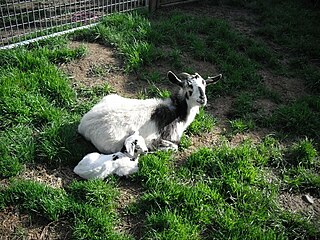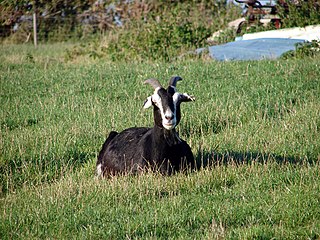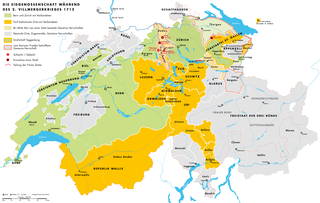The Dutch Toggenburg goat breed was developed in the Netherlands from crosses between Dutch Landrace goats and the Toggenburg goat. It is used for the production of milk..

The counts of Toggenburg ruled the Toggenburg region of today's canton of St. Gallen, Switzerland, and adjacent areas during the 13th to 15th centuries.
Toggenburg may refer to:

Toggenburg is a region of Switzerland. It corresponds to the upper valley of the river Thur and that of its main tributary, the Necker. Since 1 January 2003, Toggenburg has been a constituency (Wahlkreis) of the canton of St. Gallen.

The Toggenburger or Toggenburg is a Swiss breed of dairy goat. Its name derives from that of the Toggenburg region of the Canton of St. Gallen, where it is thought to have originated. It is among the most productive breeds of dairy goat and is distributed world-wide, in about fifty countries in all five inhabited continents.

The Kiko is a breed of meat goat originating from New Zealand. Kiko comes from the Māori word for meat. The Kiko breed was developed in the 1980s by Garrick and Anne Batten, who cross-bred local feral goats with imported dairy goat bucks of the Anglo-Nubian, Saanen, and Toggenburg breeds. The only aims of the breeding programme were fast rate of growth and ability to survive in the pastoral conditions of the New Zealand hill country.

A pack goat is a goat used as a beast of burden, for packing cargo. Generally, large wether goats are used for packing, though does may also be packed. While does are generally smaller and therefore able to carry somewhat less cargo, they may also provide fresh milk.

The Alpine is a medium to large sized breed of domestic goat known for its very good milking ability. They have no set colours or markings. They have horns, a straight profile and erect ears.

The Appenzell, French: Chèvre d’Appenzell, German: Appenzellerziege, is a rare and endangered indigenous breed of white domestic goat from Switzerland. It originates in the "half-cantons" of the historic Appenzell region, Appenzell Ausserrhoden and Appenzell Innerrhoden, and has spread into the neighbouring Canton of St. Gallen.

The Bionda dell'Adamello is an indigenous breed of domestic goat from the Val Camonica in the province of Brescia, in Lombardy in northern Italy. It takes its name from the massif of the Adamello, part of the Adamello-Presanella subsection of the Rhaetian Alps. It is raised mainly in the Val Camonica, the Val Saviore and the mountains of Brescia; some are found in neighbouring areas of the provinces of Bergamo to the west and Trento to the east. It was in the past known simply as the Capra Bionda or as the Mustàscia.

The Dutch Landrace is a traditional Dutch breed of domestic goat. It has been known in the Netherlands since the seventeenth century, and was formerly numerous there. It came close to extinction in the 1950s, but was saved by cross-breeding with unrelated goats, and by 2020 numbered over 2000 head.

The Thuringian goat breed from Thüringen in central Germany is utilized for the production of milk. It is a variety of the German Improved Fawn goat breed. The Thuringian goat breed is derived from the selective-breeding of crosses between Toggenburg, Harzerziege, Rhönziege, and Thüringer Landziege goat breeds. It is well-adapted to mountainous regions but is almost extinct.

Goats expressing the Swiss Marked pattern have a black body and belly and tan legs, ears, and facial stripes. The allele which codes for this pattern is located at the agouti locus of the goat genome. There are multiple modifier genes which control how much tan pigment is actually expressed and so the tan areas can range from pure white to deep red. There may also be present dilution genes which turn the black areas in the pattern to either chocolate or medium brown.

American Lamancha, or more commonly, simply Lamancha or LaMancha, is a formally recognized breed of dairy goat, first bred in California by Mrs. Eula Fay Frey about 1927. Later she moved the herd to Glide, Oregon for further development. The Lamancha goat is a member of the Capra genus, specifically Capra aegagrus hircus, like all domestic goats.
The American Dairy Goat Association or ADGA is a United States not-for-profit corporation dedicated to dairy goats. Its purpose is to promote the dairy goat industry, by providing and circulating sound information about goats and goat's milk; maintaining and publishing herd books and production records of milk goats; and issuing certificates of registration and recordation; improving and developing the milk goat breeds; and providing publicity and service for the goat dairying industry. The principal operation of the corporation is in Columbia, Missouri, and its headquarters are in Spindale, North Carolina.

The British Alpine goat is a breed of domestic goat developed in the early 1900s. A standard British Alpine goat is black all over with white 'Swiss' markings. Another well-known breed that has these markings is the Toggenburg goat, and the breed was developed from the Toggenburg, native British goats, and Nubian genetics. The British Alpine is a high producer of quality goats' milk, and the breed can be found in many goat dairies as an acceptable milker. These goats are capable of extended lactations, sometimes even lasting close to two years.
Clonmore is a hard cheese made from goat's milk, with a waxed rind. It originates from Charleville, County Cork in Ireland and is produced by Tom and Lena Biggane on their farm outside Newtownshandrum since 2001.

The Toggenburg War, also known as the Second War of Villmergen or the Swiss Civil War of 1712, was a Swiss civil war during the Old Swiss Confederacy from 12 April to 11 August 1712. The Catholic "inner cantons" and the Imperial Abbey of Saint Gall fought the Protestant cantons of Bern and Zürich as well as the abbatial subjects of Toggenburg. The conflict was a religious war, a war for hegemony in the Confederacy and an uprising of subjects. The war ended in a Protestant victory and upset the balance of political power within the Confederacy.
The Bormina is an indigenous breed of domestic goat from the Valtellina, in the northern part of the province of Sondrio, in Lombardy in northern Italy. It is particularly associated with the area of the comune of Bormio, from which its name derives. Because of the reddish colour of its coat and its clear Swiss markings, it may also be call the Frisa Rossa. It is raised mainly in the Valtellina but is also reported from the Lario and from the area of Varese. It does not have official recognition in Italy, and breed numbers are very low. Management is extensive: the animals are kept on high alpine pasture in the summer months, and brought under cover in winter.
The Di L'Aquila or Capra di L'Aquila is an indigenous breed of domestic goat from the province of L'Aquila, in Abruzzo in southern Italy. It is raised only in that province. It is a heterogeneous breed with variable characteristics, showing the influence of introductions of Alpina Comune, Girgentana, Maltese and Toggenburg stock. It is large, hardy and productive. Management is extensive: the animals are kept on mountain pasture, and brought under cover for protection from the snow only in the winter months.